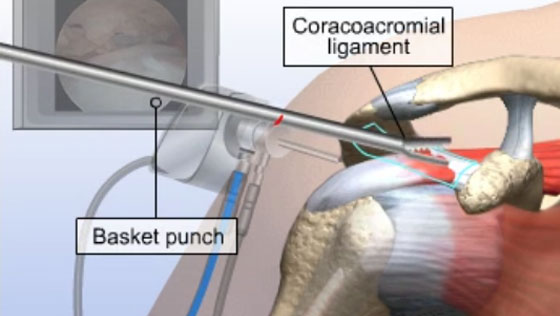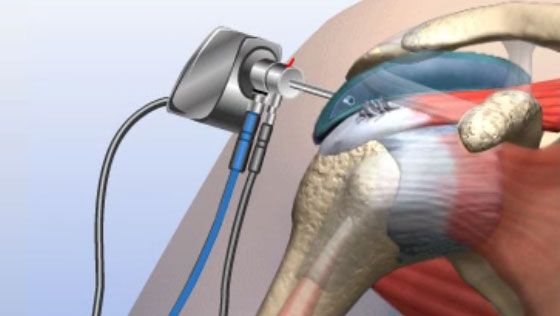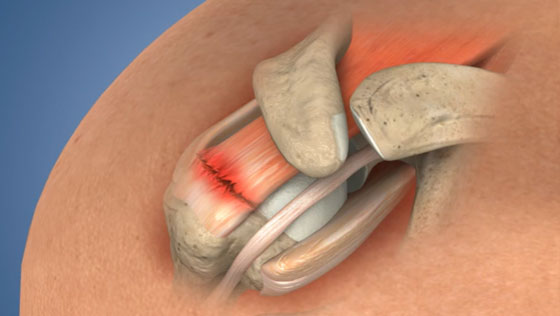What is Distal Clavicle Resection?
Key statistics about Distal Clavicle Resection
- Approximately 4.5 million patient visits that are associated with shoulder pain occur annually in the United States[1]
- Up to 65% of all shoulder problems are associated with shoulder impingement syndrome[2]
- In one study, 82% of individuals who underwent distal clavicle resection along with subacromial decompression, reported being satisfied or very satisfied with their results two years after their procedure[3]
Shoulder Anatomy
The shoulder is a ball-and-socket joint formed by three bones: the humerus, the scapula, and the clavicle. The acromion is a bony process on the upper outer edge of the scapula. The acromion joins the clavicle to create the acromioclavicular joint (AC joint).

The rotator cuff is made up of a group of four tendons and muscles that surround the shoulder joint. These muscles are the subscapularis, the supraspinatus, the infraspinatus, and the teres minor, and together they work to stabilize the joint and move the arm.

Why is Distal Clavicle Resection performed?
Distal clavicle resection is primarily performed to address pain, weakness, and loss of joint mobility due to shoulder impingement syndrome (SIS). Shoulder impingement is a result of too little space between the acromion and the rotator cuff tendons, causing the tendons to rub against the underside of the acromion, leading to tendon damage.
Shoulder impingement syndrome is caused by:
- Swelling of the rotator cuff tendons due to traumatic injury, repetitive movement, or as a normal consequence of aging
- Bone defects of the acromion such as bone spurs
The acromioclavicular joint also may be impacted by rotator cuff injury, which reduces the space between the tendons and the AC joint, leading to osteoarthritis.
Distal clavicle resection may be necessary to remove the end of the clavicle in order to create more space between the bone and rotator cuff.
Subacromial decompression also may be recommended to address shoulder impingement. Additionally, full or partial rotator cuff repair can be necessary, depending upon the extent of tendon damage.
Who needs Distal Clavicle Resection?
Shoulder impingement syndrome is most commonly the result of repetitive movement from participation in throwing or overhead sports, or by traumatic injury such as a fall.
Distal clavicle resection is a surgical procedure that may be performed to address shoulder impingement syndrome or osteoarthritis of the AC joint that cannot be treated with nonsurgical measures.
How is Distal Clavicle Resection performed?
- The surgeon will make small incisions around the shoulder joint and the arthroscope will be inserted into one of the incisions.
- Saline solution is pumped into the joint to expand it and improve visualization.
- Images from the arthroscope are sent to a video monitor where the surgeon can see inside the joint.
- The end of the clavicle is removed.
- Finally, the saline solution is drained, instruments are removed, and the incisions are closed using sutures.
What are the risks of Distal Clavicle Resection?
Risks associated with distal clavicle resection may include:
- Infection
- Nerve and blood vessel damage
- Pain
- Shoulder stiffness
How long does it take to recover from Distal Clavicle Resection?
-
24 hours after surgery
Most patients are able to return home the same day as their procedure, and pain medication may be prescribed. A physical therapy routine will be established by the surgeon and physical therapist. A sling may be provided, but it is important that prescribed exercises are followed in order to prevent the development of any weakness or stiffness. -
2 weeks after surgery
Any non-dissolvable sutures are removed and bruising and swelling begin to subside. -
4-6 weeks after surgery
Most patients are able to discontinue use of the sling and resume most daily activity. -
8-12 weeks after surgery
Most patients are fully recovered from distal clavicle resection.
What are the results of Distal Clavicle Resection?
Distal clavicle resection is a safe and effective procedure performed to alleviate pain and restore shoulder function to patients suffering from shoulder impingement syndrome. In one study 82% of individuals who underwent distal clavicle resection along with subacromial decompression reported being satisfied or very satisfied with their results two years after their procedure[3].
Find an Orthopedic Doctor in Your Area





